Today, I’m going to give you some inside details.
This is probably the single-most important topic in Forex trading:
Order Flow Trading.
Order Flow trading is the topic that completely changed my trading (for the better) and took me from being an inconsistent beginner to a consistent, profitable trader.
Order Flow trading is, without a doubt, the elusive holy grail of Forex.
This is not hyperbole!
Order Flow trading is absolutely the toughest aspect of all trading to wrap your head around.
Once you “get it” everything changes.
You will begin to see the Forex market for what it really is:
A collection of groups buying and selling for their own intents and purposes:
Profit!
You will see:
The core focus of Order Flow Trading is: the understanding of other traders.
Have you noticed:
How everyone always focuses on price in Forex?
“What’s price doing right now: rising or falling?”
“Is it about to burst through a support level?”
“Where is it on the price chart?”
Price is important, no doubt, but what is going on behind the scenes?
What is creating the price action everyone can see; this is even more important?
Simply put; and this might pee some people off,
You can’t predict price using price; it’s impossible!
For example:
A supply and demand zone won’t make price reverse. It’s just a box on the chart!
It’s what traders, and especially the banks, DO at the zone that causes it to reverse!
The zone represents a point where they bought or sold.
So, the banks may decide to buy or sell again depending on their situation.
It’s what the banks decide to do at the zone which determines whether price reverses or not.
It is NOT the zone itself.
SO: we should always think about the actions and decisions of other traders.
And that, ladies and gentlemen,
friends, traders and all you smart VIPs reading this,
is what Order Flow trading is all about:
Predicting and anticipating the actions of other traders.
NOW, Order Flow trading is a tough topic. You won’t pick it up in a day, that’s for sure.
It takes time, experience, and intuition to understand how different groups of traders think and make decisions. And even then, you still won’t “get it” fully. People are complicated, after all.
However, today, in this monster guide,
I’m going to explain Order Flow trading,
in understandable language,
so you can unlock its secrets and start using it in your trading.
Here’s what we’ll look at:
What Is Order Flow trading And How Does It Work?
The Role Of Liquidity In Order Flow, and
How Liquidity Creates The Movement We see.
We will be going deep into:
The 3 Order Types And Their Affect On Liquidity, and
How To Get The Order Flow Mindset, and
How to Start Using Order Flow In Your Trading, and
Why Losing Traders Generate Most Price Movement and
How to Take Advantage.
Then we will see how the other side works:
How to gauge what the banks will or will not do
by understanding the banks’ limitations, and the reason
Stop Hunts are so important in Order Flow and
How to predict Stop Hunts in advance.
This is a biggie!
I would suggest something warm in a cup, soft under your butt and open in your mind.
You are about to challenge:
your preconceived notions of the market,
your understanding of finance and
your ability to hold several incongruous ideas in your mind at the same time.
So, are you ready to get into this guide?
Let’s jump in and learn what Order Flow Trading is all about…
Important:
What Is Order Flow Trading And How Does It Work?
Order flow trading is akin to a grand chess game in the forex world, where every move carries weight and repercussions.
Here’s the crux of the idea:
Price fluctuations aren’t arbitrary, they are a result of the intricate dance of buying and selling that traders perform. That’s no revelation. But here’s a fresh perspective – why laser-focus solely on price?
See, price is the outcome of all the calculated decisions made by market players, not the instigator. So, instead of studying just the price, let’s decode the actions of other traders. Their strategic maneuvers – from profit-taking, executing or closing trades – orchestrate the price we observe.
To put it simply, order flow trading is a sophisticated art of anticipation and prediction of fellow traders’ moves.
Think of it as a high-stakes poker game.
In poker, success hinges on accurately predicting your opponents – are they bluffing, or do they hold the trump card? Order flow trading mirrors this strategy.
We examine the cards on the table and ask ourselves:
- Where have traders drawn their lines in the sand with stop orders?
- Who’s riding the wave of profit and who’s caught in a storm of loss?
- What price points could trigger a mass exodus of traders closing positions?
These actions and numerous others create a current – the order flow – which drives price change. Thus, if we can discern and predict these traders’ actions, we can forecast price shifts ahead of time. This foresight can give us a commanding advantage in the high-octane world of trading.
Order Flow Trading 101: Understadning Liquidity
We can’t delve into the realm of order flow without talking about liquidity. It’s an essential concept and a cornerstone to truly understanding the dynamics of order flow trading.
So, what’s liquidity all about?
Sit tight, we’re about to go deep.
Simply put, liquidity refers to the ease with which you can buy or sell a currency without causing substantial price movements.
Ever wondered why trading the major currencies is always encouraged?
Yep, it all boils down to liquidity.
Major currencies are the heavyweights in the ring due to their superior liquidity. It’s like they’ve taken a sip from the fountain of ‘liquid’ youth. Transactions involving major currencies like EUR/USD are a walk in the park, thanks to a high liquidity level.
A wealth of eager buyers and sellers stand ready to meet your price expectations.
You want to buy EUR/USD?
No problem, you’ll find sellers galore!
But it’s a different story with the minor currencies.
They’re the underdogs with low liquidity. Finding a partner for your buy or sell order is a bit of a challenge here. Not as many players are willing to trade or use these currencies. Yes, buyers and sellers exist, but they’re sparse, making it tough to strike a deal at your desired prices.
So, what determines liquidity?
It comes down to the popularity of the currency amongst traders, businesses, and the like.
Consider EUR/USD, the poster child for high liquidity.
Representing two of the globe’s economic giants, the USA and the EU, this currency pair is used widely by various countries (or states in the case of the USA). This popularity ensures that buying or selling EUR/USD is as smooth as butter.
A host of individuals and businesses, both domestic and international, need this currency, resulting in a thriving market of buyers and sellers.
Now, let’s switch to minor pairs for a bit…
USD/NOK is a classic case of low liquidity. The NOK represents Norway, a relatively small country where the currency is mainly used.
This limited use contributes to the high spreads.
Trading USD/NOK can be a challenging endeavor as the pool of potential buyers and sellers is significantly smaller.
Liquidity And Order Flow Trading
Generally, currencies teeter between being liquid or illiquid. But here’s the kicker – all currencies oscillate between periods of high liquidity (easy trading) and low liquidity (tough trading), simply due to the ebb and flow of the market.
Put it this way:
You have those golden moments when trading is a breeze (hello, high liquidity).
Then there are those frustrating patches when trading feels like trying to squeeze a camel through a needle’s eye (that’s low liquidity for you).
Here’s a fundamental fact to get your head around: Price shifts, be they seismic or minor, ONLY occur when liquidity dries up on one side of the market – either the sell-side or buy-side.
So, when the buy-side liquidity is drying up, the price skyrockets – there just aren’t enough buy orders to meet the sell orders.
On the flip side, when sell-side liquidity is scarce, the price takes a nosedive – sell orders can’t keep up with buy orders.
And naturally, the opposite is true too.
This dearth of liquidity – the capacity to trade without triggering massive price shifts – means the price has no choice but to veer in the opposite direction.
We need more orders on the opposing side.
The sellers are offloading too much for the buyers to absorb, causing the price to fall until more buy orders can restore the balance.
Scratching your head?
Here’s a simplified example:
Meet little Johnny. He’s keen to buy 100 lots of Eur/Usd, but there’s a hitch: only 20 lots are up for grabs, leading to a sell-side liquidity drought – there just aren’t enough traders selling to cover his whopping buy order (100 lots).
So, if Johnny leaps in and buys now, what’s the most likely outcome?
- Does the price surge?
- Does it stagnate?
- Or does it plummet?
If you guessed “the price surges”… you hit the nail on the head.
The price has no option but to climb. Johnny’s 100 lots need to be covered – we need more sellers to balance the scales.
Thus, the price will keep climbing until those elusive sellers are roped in; there’s no ceiling here!
Johnny’s initial 20 contracts aren’t an issue – 20 lots are available at the current price, which happily pair up with his 20 lots. He manages to snag 20 lots at his desired price because there’s a perfect match in terms of availability (20 lots). So, they link up effortlessly.
But what about the remaining 80 lots?
Well, they get picked up at gradually escalating prices…
As the price creeps up, more sellers get lured in, filling the 80 lots bit by bit until Johnny’s full 100 lot order is satisfied. At this point, the market regains its equilibrium – or flips if the sell orders suddenly outweigh the buys.
In the realm of order flow trading, this phenomenon is dubbed “slippage”, and it’s the engine driving almost ALL market movement.
See for youselfs…
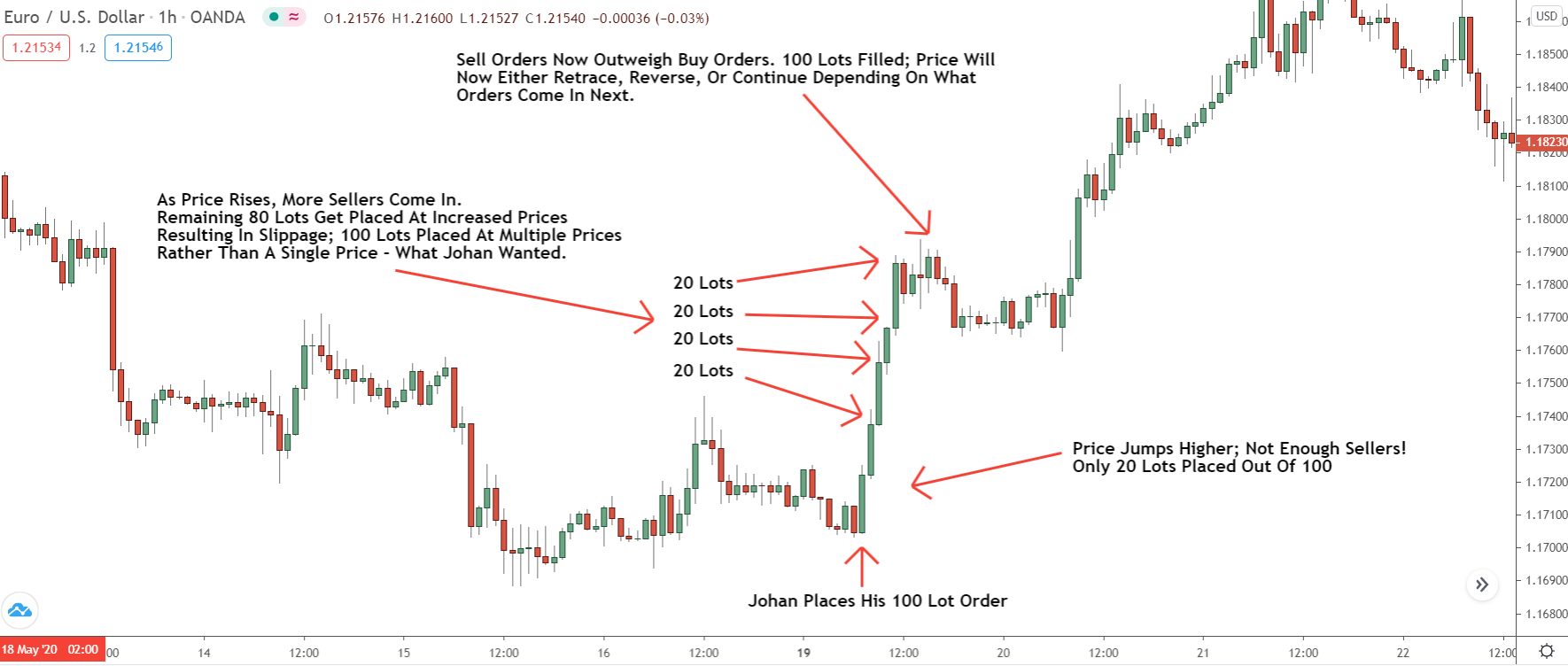
Swift price surges occur when an influx of buy orders flood the market, dwarfing the incoming sell orders — and these orders aren’t necessarily initiated by traders.
Because these buy orders significantly outweigh the sell orders, we end up with a phenomenon called ‘slippage.’ The price must ascend to draw in more sellers (and, consequently, more sell orders) to pair with the surplus of buys.
Once an equilibrium is reached — when enough sellers are found — the market stabilizes.
Prices may then flatline or even reverse if sell orders start to outweigh the buys.
What determines the price climb?
Well, that hinges on:
- The magnitude of the incoming buy orders.
- The scale of sell orders streaming in as the price ascends.
Picture a situation with no sellers, hence, no sell orders.
When only a smattering of traders reckon the price should dip, we’ll see a mere trickle of sell orders. This situation triggers a price surge — much like during market crashes or other large-scale events when prices plummet drastically.
In these scenarios, sentiment is overwhelmingly negative; nobody wants to buy:
Zero buyers equals zero buy orders to match with sell orders, catalyzing a market crash.
Now, let’s flip the script…
When prices are climbing and a multitude of sellers predict a downward trend — like in the midst of a steep downtrend — the price ascension is more gradual. We’ll see a cascade of sell orders, implying it takes heftier buy orders to tip the scales and instigate a price rise.
This is why, in Supply & Demand (S & D) trading, strong zones form not following a sudden shift — as most experts suggest — but after a prolonged preceding movement. It demands a greater force to propel the price in the opposite direction because the market is heavily skewed towards buying/selling due to the movement.
Suppose the price had been tumbling for an extended period before a demand zone emerged. In that case, most traders are likely selling and would see the price rise as an opportunity to enter the down-move at a better price.
This scenario requires even larger buy orders to lift the price, thereby creating a robust demand zone.
Does it all click into place now?
Understanding The 3 Order Types And Their Affect On Liquidity
Liquidity pivots on the caprices of the market – but what sparks those shifts?
Let’s mull over it: traders are the linchpins, buying and selling commodities. But let’s dig deeper:How do these traders engage with the market, enabling buying and selling?
The answer lies in…
Orders – precisely, three types.
It’s not just traders who stir up liquidity changes with their actions… it’s the orders serving as their tools that truly drive the market dynamics.
Market orders, limit orders, and stop-loss orders (a variant of limit orders) each impact liquidity uniquely, either contributing to or depleting it from one side of the market. The result? Either low or high liquidity scenarios – manifesting as either sharp or gradual price shifts.
Let’s dissect these three order types and their influence on liquidity.
First on the list…
Market Orders (Deplete Liquidity)
Market orders are our bread and butter, providing an immediate entry into the market at a price hovering around the current quote.
Their convenience is undeniable, yet here’s the kicker…
Market orders DRAIN liquidity from one side of the market – making buying or selling a tougher ordeal.
When you resort to a market order, what’s the underlying intention?
What’s the liberty it offers?
It’s simple: you can buy or sell on the drop of a hat at a price aligning with the current market rate.
THE CRUX: You’re declaring: “I need to buy/sell this instant; locate me a buyer/seller”, no matter their availability.
This urgency – “locate me a buyer/seller pronto” – DRAINS liquidity from the other side of the market.
You’re clamoring for an opposing order, piling up the pressure on the other side, nudging the price to move your way – given the scarcity of orders.
Assuming you’re selling and buyers are out in the market, placing sell orders matching or exceeding your order size, your transaction goes through – your currency is sold. This stands true regardless of whether you entered the market, took profits, or closed a trade – all these actions hinge on sellers, don’t forget!
But what if buyers are out there but placing orders LESS than your market order size; what’s the fallout?
It’s straightforward: Your trade only gets partially executed – in trader lingo; you’ll face slippage.
The price will then climb until more sell orders surface; your order will scatter and get placed at progressively higher prices. A parallel can be drawn with our case study Johnny, who aimed to buy way more than what sellers had on offer.
The outcome?
A sudden surge – with no sellers in sight, the price leaped until sellers found the escalated prices enticing enough to sell.
Limit Orders (Add Liquidity)
Market orders are the bread and butter for most traders.
However, limit orders – also known as pending orders – play their part in the trading symphony, influencing the market differently than their market order counterparts.
Let’s delve into the world of limit orders.
They enable you to buy or sell when the market touches a specified price. You set the order, patiently await the price to hit your trigger point, and when it does – voila! Your order swings into action, buying or selling accordingly.
Sounds straightforward, right?
Here’s the twist. A limit order ensures there’s always a buyer or seller hanging around at a specific price. As long as the order is untriggered, it symbolizes an eager buyer or seller, ready to pounce at that price.
It’s an order awaiting its perfect match to execute.
And why does this matter?
Because, unlike market orders, limit orders sprinkle liquidity into the market, making the process of buying or selling smoother, not steeper.
Think of it this way: if an order exists at a particular price, someone’s primed to buy or sell as soon as that price is hit.
They’re ready to be coupled with opposing orders, injecting liquidity into the market.
Sure, for small fish like us, it’s not a biggie – we don’t deal in gigantic volumes. Liquidity is far from being our headache – our modest orders get paired up without a hitch, thanks to their bite-sized nature.
But it’s a different ball game for the large-cap traders.
Liquidity is their constant bugbear.
Their mammoth buy and sell orders often struggle to find enough counter-orders – even during peak trading hours. Hence, they strategically drive the price to levels swarming with limit orders to smoothly position their trades.
A case in point is the big round numbers – prices ending in 00, 000, 0000. These levels act as magnets for limit orders, attracting them due to their market significance.
Curious why?
You can dig into that in this post.
Banks, the sly foxes they are, exploit this trend. They propel the price to these big round numbers (BRNs) intentionally, setting off a cascade of limit orders to facilitate their trades. That’s why we often observe huge reversals at or in proximity to BRNs.
Flick through a chart, and you’ll soon witness this phenomenon!
So here’s the takeaway: Limit orders nourish the market with liquidity. They ease the process of trading, not complicate it.
Remember this, and strive to identify locations brimming with limit orders.
Sure, BRNs are obvious hotspots, but don’t overlook specific technical points such as major support and resistance levels. Also, watch out for significant prices – like the memorable 1.300 level on CHF back in the day.
These areas are just as appealing to limit orders and deserve your vigilant monitoring.
Stop Orders (Add & Remove Liquidity)
When it comes to the three kinds of trading orders, stop orders steal the spotlight. They’re a unique hybrid, acting as limit orders when placed and morphing into market orders upon execution. It’s like they have a dual citizenship in the trading world, both contributing to and withdrawing liquidity from the market.
Now, this dual role comes with its fair share of implications in trading.
Here are the two big ones…
#1 Implication of Stop Orders: Triggered stops can cause sharp price moves: (aka stop cascades)
Firstly, stop orders can trigger price earthquakes, causing sudden, sharp shifts in price – a phenomenon we refer to as “stop cascades.”
Why does this happen?
Simple.
A stop order, once triggered, transforms into a market order, siphoning liquidity from one side of the market. In trader’s terms, it’s like someone banging the gavel demanding an opposing trader to pack up and leave. When this scene repeats on a large scale, it often results in a stop cascade – a sudden price tsunami in the opposite direction.
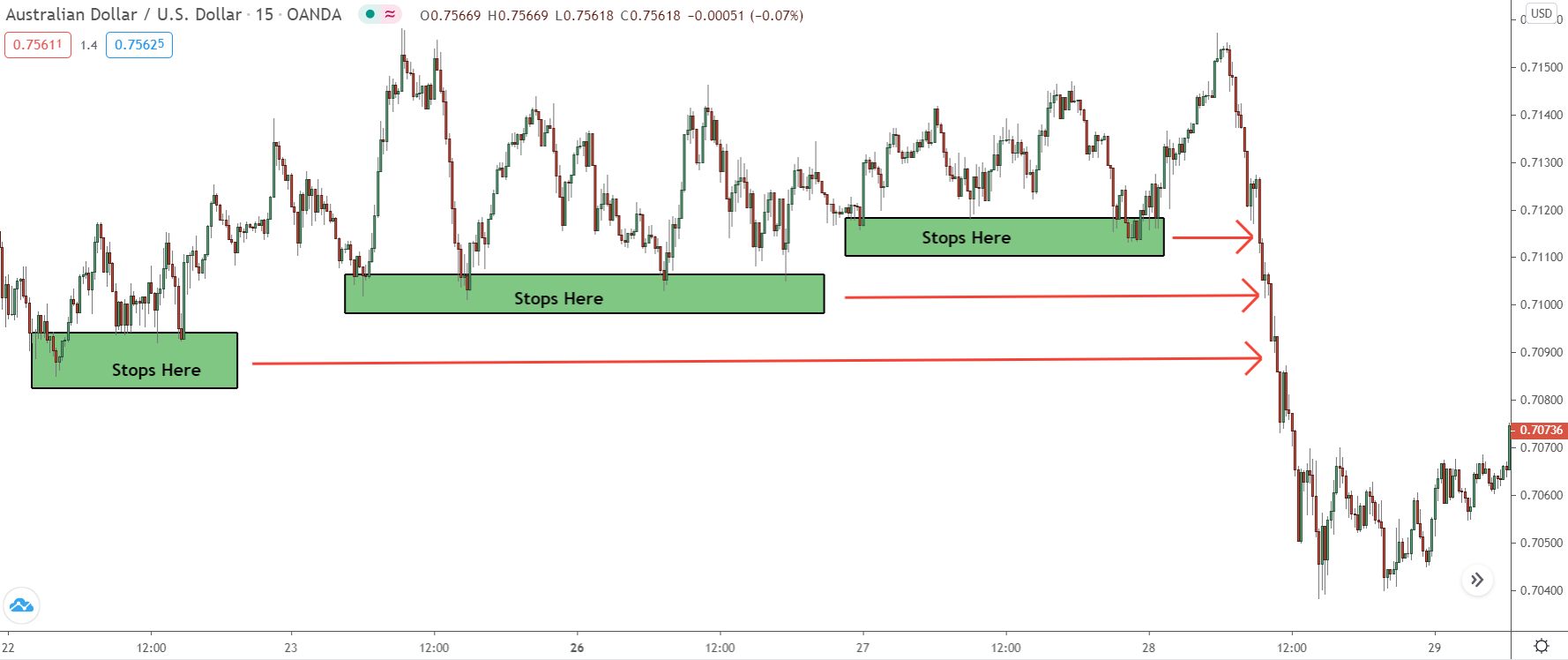
Typically, when a series of significant swing highs or lows — key points where traders usually set their stops — align closely, a dynamic event called a ‘stop cascade’ takes shape, as illustrated above.
As price breaches the first high, stop orders get triggered.
This event incites a miniature stop cascade, nudging the price beyond the next high.
A subsequent stop cascade ignites, propelling the price above the final high, triggering yet another cascade.
Each miniature cascade serves as a catalyst for the next one.
The end result is a sudden, sharp ascent above all the highs within mere minutes. So, when you spot an array of swing highs or lows clustered together, stay alert… a stop cascade might be brewing.
#2 Banks Leverage Stops to Strategize Their Positions (Stop Hunts)
Remember the narrative about limit orders? How banks maneuver price to specific points where they can accumulate substantial numbers to facilitate their own orders?
Well, stop orders play by the same rules.
Banks intentionally ignite stop accumulations to aid in positioning their own orders.
Given that these become limit orders once placed, banks often target clusters of stops. These limit orders can then be used to balance out their own orders. This tactic in forex is known as ‘Stop Hunting.’ And chances are, you’ve unwittingly been a part of this or have witnessed it unfold.
Ponder this…
How often have you seen a price spike hit a low or high and knock you out of your trade?
Frustrating, isn’t it?
More often than not, the rationale behind such an occurrence is that the banks deliberately triggered the accumulated stops around the low/high to execute their own orders.
Big players in the market orchestrate these ‘stop runs’ to trigger orders, exploiting them for their own gain — inevitably causing your loss. Stop hunts are a central aspect of order flow trading. In due course, I’ll guide you on how to foresee their occurrence so you can turn the tables in your favor.
Order Flow Trading Is Basically Poker Applied To Forex
Order flow trading, at its heart, is a strategic mind game, akin to poker or chess.
It requires predicting fellow traders’ moves. While we gaze at the same market tableau as everyone else – price charts – we peer deeper. We go beyond the price, unlike the majority of traders, delving into the psyche of our market companions.
Let’s not forget, it’s PEOPLE who steer the market.
Price doesn’t stroll around solo.
As such, it’s critical to decode the decision-making process of fellow traders.
By doing so, we can forecast the market’s motion well before the price-only traders do, providing us with an unambiguous edge.
But, how do we unravel the intentions of other traders?
What’s our secret weapon?
First off, we decode the market’s DNA, its fundamental elements such as liquidity and order mechanics. This gives us insights into how fellow traders’ actions will impact the market.
Then, we delve into the mind of our fellow traders by asking probing questions. These questions force us to consider their actions and the ripple effects they may have on the market, such as:
- What is the fate of currently losing traders when they finally decide to close?
- Where are the stop-loss orders tucked away?
- What maneuvers could banks pull off with the present set of orders?
These actions, along with many more, substantially influence the market’s direction. As order flow traders, it’s our responsibility to anticipate their occurrence and impact. This intelligence then fuels our trading strategies, propelling us to make informed, calculated decisions.
“Price movement? It all comes down to liquidity – your ability to buy or sell.
In forex trading, liquidity refers to how easy it is to buy or sell an asset, in this case, currencies. The liquidity of a currency is proportional to the magnitude of the economies it represents.
Major pairs are liquid, thanks to the large economies backing them.
On the flip side, minors and exotics are less liquid due to their relatively smaller economies.
Currencies can either be liquid or illiquid, although this status isn’t set in stone. Every single currency, whether liquid or illiquid, oscillates between phases of low and high liquidity.
In a nutshell, there are periods when buying or selling becomes a massive task (low liquidity), and other times when it’s as easy as pie (high liquidity).
Interestingly, it’s never simultaneously tough or easy to buy and sell.
High sell-side liquidity makes selling a breeze because there’s a multitude of buyers. The same principle applies to the buy-side: the more the buyers, the easier it is to purchase a currency.
And guess what?
This concept applies to all buy actions – be it placing buy trades, closing sell trades, or taking profits off sell trades.
They all need buyers to materialize, just as selling requires the opposite scenario.
Although high liquidity simplifies buying or selling, the reverse is true for low liquidity.
The major takeaway?
Every twitch in forex prices is orchestrated by liquidity or the lack thereof.
All surges and dips, no matter their magnitude or duration, are birthed from a liquidity deficit. The degree of this deficit determines the pace of price movement: a higher deficit triggers sharp moves while a smaller one results in slower, gradual shifts.
If sell-side liquidity is scant, prices soar – the incoming sell orders outnumber the buy orders.
If buy-side liquidity is scarce, prices plunge – buy orders eclipse sell orders.
Don’t be misled into thinking that it’s about having ‘more sellers than buyers.’ It’s more nuanced than that. It’s all about order sizes. When larger sell orders pour in compared to buy orders, prices have to tumble to seek out more buyers to match the sell orders.
The larger the sell orders, the higher the number of buyers needed, and the deeper the price will dip.
So, what’s the bigger picture?
Liquidity fluctuates primarily due to traders’ actions, but the type of orders they place also significantly influences these shifts. They can either add to or drain liquidity from the market, altering the ease of buying or selling and, consequently, dictating future price movements.”
How To Get The Order Flow Mindset
Still with me?
Time for a breather.
Order Flow trading demands a fair share of out-of-the-box thinking. It leans more on gut feel than price-action trading. It pushes you to draw inferences from data that can’t be validated or verified: nailing down the actions of other traders!
We aren’t sitting around for indicators to cross paths or flash a signal.
We aren’t tuning into news channels for puppet-show journalism.
We are scrutinizing what other TRADERS are up to.
We’re watching the same show the banks are.
We’re keen on knowing when the next batch of retail traders is ripe for picking.
SO:
How do you get into the headspace of an Order Flow trader?
What’s the drill?
Well, you need to start thinking about the sheep.
That’s right, SHEEP!
The sheep, the herd, the minnows, the greenhorns:
Call them what you will; they’re all cut from the same cloth – inexperienced retail traders.
These ‘sheep’ are the impulsive ones, who leap into trades without a second thought. They prefer hasty calls over logical analysis.
These reactionary traders are the SHEEP!
They react to news, crossing lines, and pretty doodles on their charts.
In Order Flow trading, these ‘sheep’ hold the key for two crucial reasons:
- The sheep drive most of the movement we observe, particularly from closing losing trades.
- The banks, the true WOLVES, exploit (and need) the sheep for their own deeds – placing trades, banking profits, and so on.
Take a look at the rise in the following chart; what do you think stirred the price climb here?
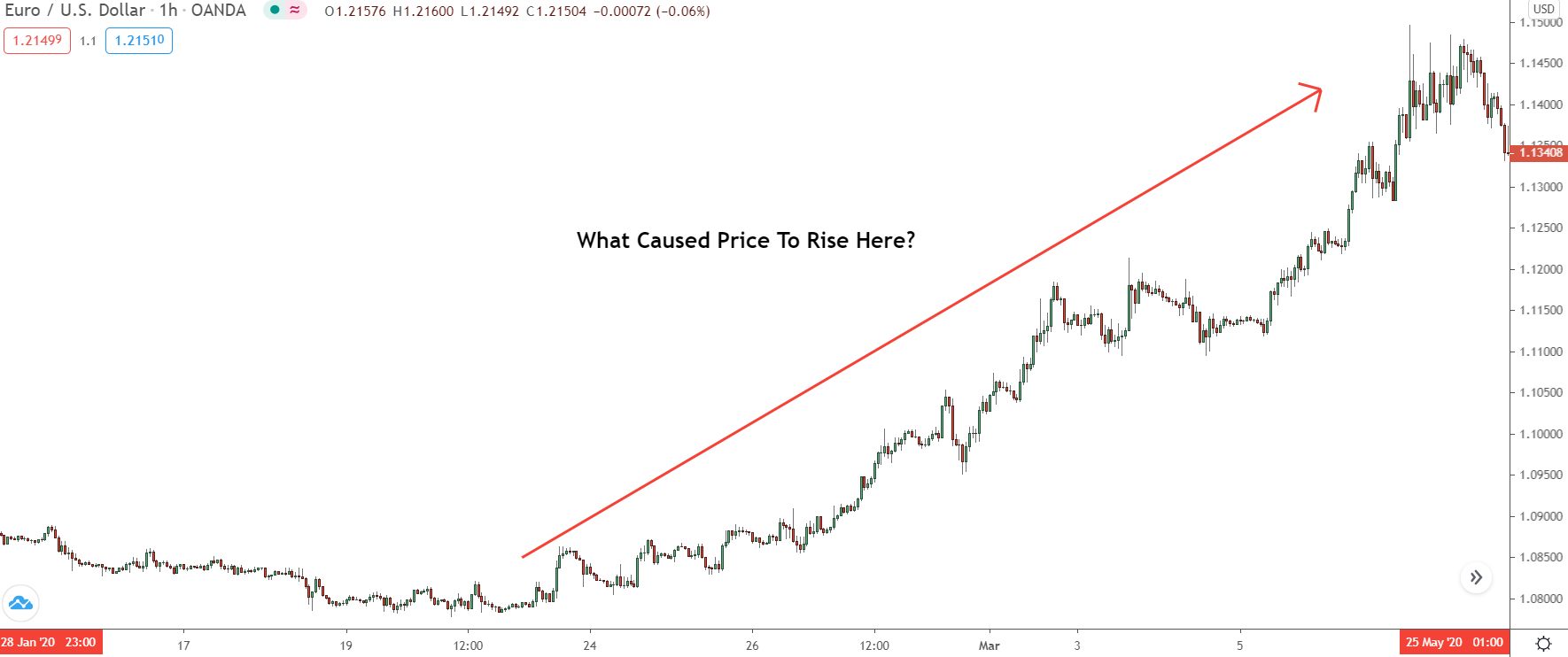
You might be thinking, “Ah, traders are buying,” and you’d be bang on.
But let’s dig deeper… Why are they buying?
Are they:
- Placing buy trades?
- Pulling the plug on losing sell trades?
- Raking in profits from open longs?
The answer is a resounding: SHUTTING DOWN LOSING SELL TRADES.
One of the most common missteps in Forex trading, and believe me, I’ve been there, is this assumption that every price move stems from traders buying or selling to place trades.
That’s a big fat NO!
Any action that pumps orders into the market stirs up price movement.
Reality check: The lion’s share of price shifts springs from traders EXITING LOSING TRADES!
Price movement isn’t usually sparked by traders placing trades, although that does contribute. It’s predominantly driven by traders exiting losing positions.
Think: how do you close a losing trade?
What’s the game plan?
Well, a trader nursing a loss must use the opposite order.
For instance, to close a losing sell trade, you need to buy back what you initially sold at a worse price. And what’s the usual fate of most retail traders (the proverbial sheep) in Forex?
You’ve got it: THEY’RE ON THE LOSING END!
And that brings us to one of the pivotal points of focus in Order Flow trading: When will these unlucky traders pull the plug on their trades?
But that’s just one piece of the puzzle.
There’s more to it than meets the eye.
Order Flow trading is a multi-faceted approach, and you’ll need to examine all angles to truly adopt the Order Flow mindset.
We can’t cover all the bases today, but here are the three critical areas to keep in mind when you’re viewing the market through the lens of Order Flow:
Why Losing Traders Generate Most Price Movement And How To Take The Advantage
In the grand arena of order flow trading, it’s essential to consider the power players – those entities that could instigate a price fluctuation through their actions.
And knowing when they’re likely to act is just as crucial.
Master this and let’s just say… you could be swimming in some BIG money.
In forex , several forces are at play – banks, the ‘sheep,’ and other large-cap traders, to name a few. Their actions are usually reliant on another group’s movements – they simply can’t operate in isolation.
Let’s dive into an example…
Suppose the banks decide it’s time to take profits from a buy trade.
They need the ‘sheep’ to buy – they have to offload what they purchased, and they can only do so when others are buying. This explains why prices tend to retract or plateau after substantial rises or falls – banks are cashing in, using the orders from the late-buying or late-selling ‘sheep.’
Now, here’s the catch – we need the banks to profit.
We’re not exactly in a position to move the market ourselves! Our sole route to profit is to hitch a ride on their trades by accurately predicting the direction.
That’s why understanding their modus operandi is so vital.
Of course, the banks are the market’s heavyweights – they’ve got the deepest pockets, after all.
BUT, traders in losing trades can also pack a considerable punch…
These traders can trigger substantial price shifts when they close their positions, creating much of the movement we observe. They reach a breaking point, unable to maintain their losing trades any longer, and are compelled to liquidate their trades at a loss, resorting to the reverse action:
A short trader on the losing end must buy back what he sold, thereby introducing a buy order into the market. Similarly, a losing long trader must sell what he bought, thereby placing a sell order into the market.
So, whenever a closure happens, the opposing order joins the market; a buyer exits, and a sell order is placed.
Just imagine the impact when tens of thousands do this simultaneously!
Price goes WILD!
In fact, it usually unfolds something like this…
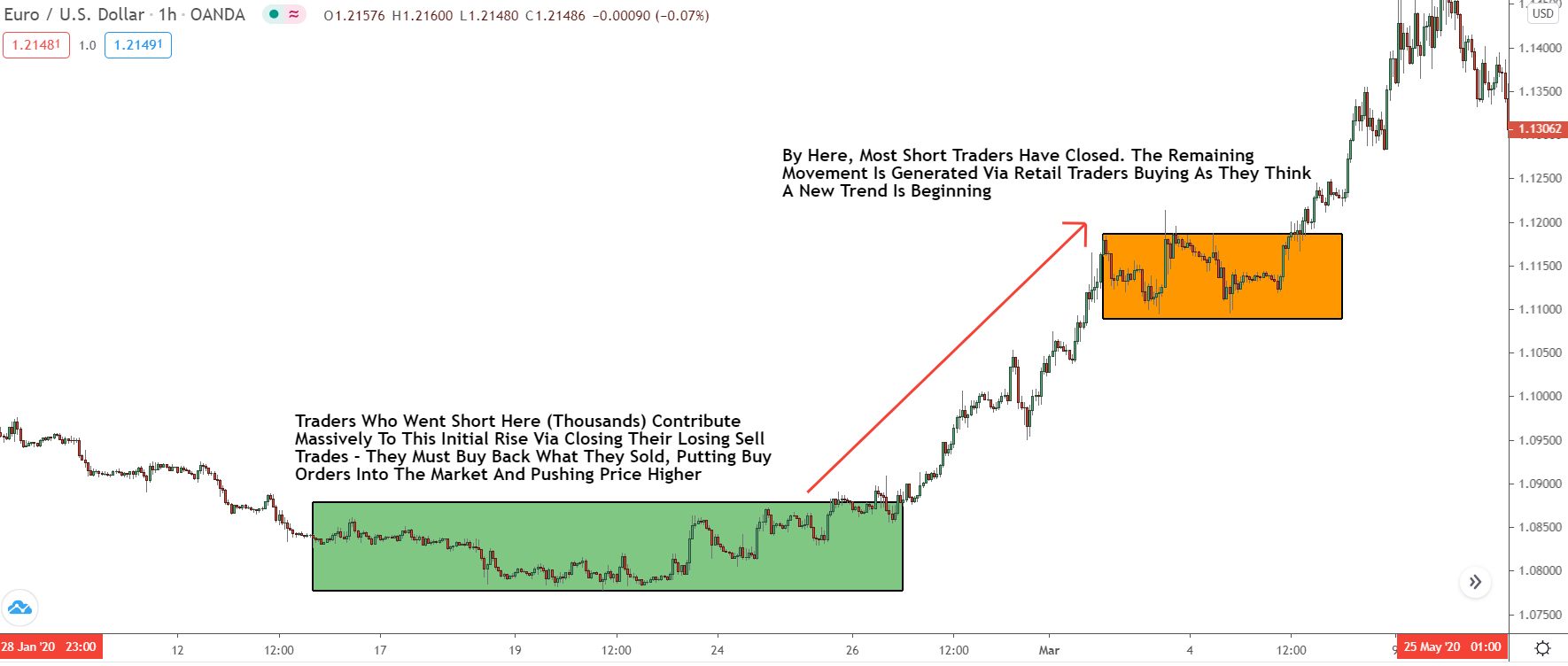
The major chunk of movement during this rise results from losing short traders pulling the plug on their trades.
They sold at the bottom of the last downward move, banking on the trend’s continuity.
As the price ascends, their trades submerge, triggering a mass closure to evade further loss – the higher the price climbs, the more traders close as their losses amplify.
So, constantly question: Where are the losing traders?
How many will incur losses if the price rises or falls?
Try to anticipate the effect the price will have on their closure timing.
If the price skyrockets, short traders will opt for a hasty exit – their losses will be significantly larger, inciting a panic-induced closure, thus accelerating the rate of price rise and propelling even more to liquidate. It’s a downright vicious cycle!
That’s precisely what transpired in the example above – the price leaped, rattling the losing traders into quick closure.
Conversely, if the price increment is slow and steady, fewer shorts will close.
The gradual uptick might give them false hope that the price could still turn in their favor, persuading them to hang on a little longer.
Factor in the number of traders that could potentially lose as well – this will give you an inkling of the kind of move you’ll witness if the price flips direction. If the price has been stuck in a long downtrend, and the market is overwhelmingly bearish, it’s likely that most traders are short.
So, what transpires if the price reverses?
A mass closure of traders could potentially spawn a substantial reversal.
Remember, the longer the downtrend, the more traders are short, resulting in a more significant reversal. This is often seen when the price sharply reverses after trending lower or higher for a prolonged period – the sharp reversal is an outcome of all traders shuttering their losing trades.
How To Gauge What The Banks Will Or Won’t Do By Understanding Their Limitations
Banks, the market maestros, rely heavily on the other traders, the “sheep,” to execute their strategies: placing trades, taking profits, and closing trades.
The type of action?
Irrelevant.
The banks’ gameplan hinges on one crucial element – the sheep must be heavily invested on the opposite side of the market, and simultaneously at that.
And it’s not just a handful of sheep we’re talking about here.
A sparse group of sheep selling?
That’s a no-go for the banks.
There simply aren’t enough sell orders for banks to place buy trades or pocket profits from their sell trades.
Just a smattering of sheep buying?
Again, it’s a stalemate.
There aren’t enough buy orders for banks to place sell trades or reap profits from their buy trades.
With this in mind, one of the primary objectives of Order-Flow trading is to decipher what maneuvers the banks can pull off with the current order landscape and predict the ripple effects of these actions on the market.
So, ask yourself this:
Can the banks place trades, take profits, or close trades; and if so, how big can they go?
To solve this puzzle, we turn our gaze back to the sheep.
What’s the buying and selling activity among the sheep looking like right now?
Since the banks are tethered to the sheep’s actions, understanding the herd’s mindset and decision-making process gives us a crystal ball into the banks’ next moves.
In essence, this is the heart and soul of order flow!
We then harness this information to strategize our trades and manage our positions.
Let’s illustrate this with a quick example…
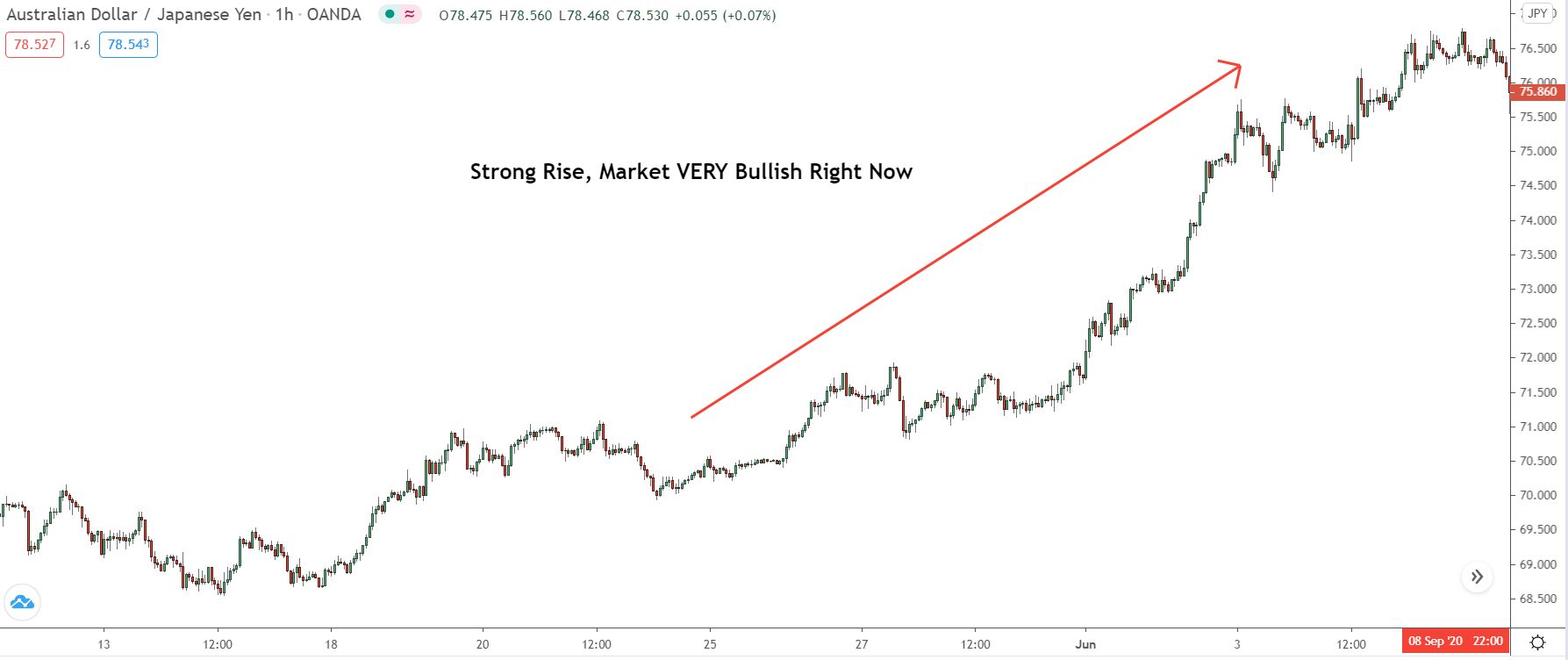
Look at the EUR/USD – the price has shot up like a rocket!
The market couldn’t look more bullish if it tried.
It goes without saying that the majority of our sheepish traders are going long right now. The recent price surge, coupled with a prior upward trend, has them convinced that the price will skyrocket to infinity – “We’re going to the moon,” they say.
With this herd mentality driving up purchases, we can be sure that the banks are sitting on a goldmine of buy orders.
The million-dollar question is, what are they going to do with them?
Well, let’s break it down.
There are only three actions that need buyers:
- Taking profits from long trades – you have to sell what you bought, and that requires buyers.
- Closing open long trades – the same deal here.
- Placing sell trades – once again, you need buyers to sell.
Here’s the rub – we can’t know for certain which of these actions the banks will take. However, by scrutinizing the market and gauging probabilities, we can make an educated guess.
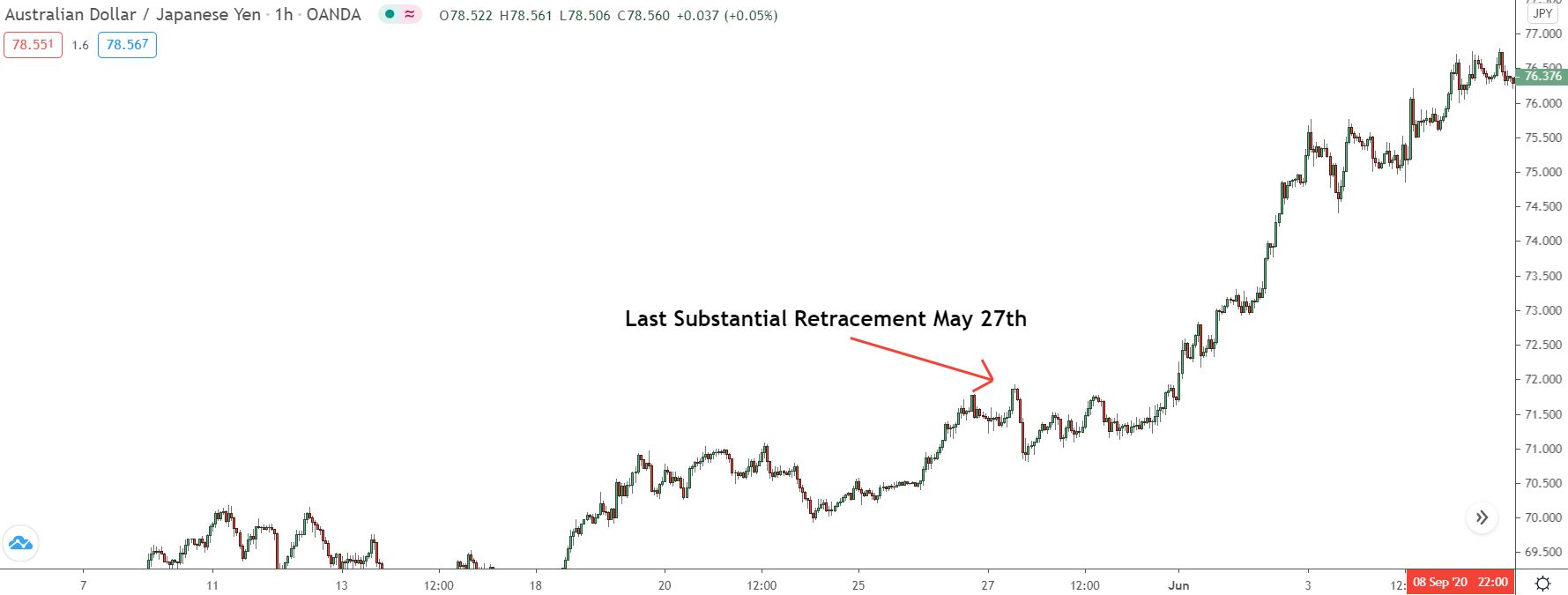
Take another look at the market move – when was the last retracement or consolidation?
Astoundingly, price has held its ground without retracing or consolidating for six market days – an absolute age in trading terms! On top of that, it’s soared by an impressive 300 pips. The banks must be on the edge of their seats – imagine sitting on a 300-pip+ profit at their scale!
This all suggests one likely scenario: the banks might soon start pocketing profits.
As they cash in, we’re likely to see a retracement or consolidation. After all, they can’t ride the wave forever; they’ll want to lock in that massive 300-pip gain!
So, scenario one is profit-taking, resulting in retracement or consolidation.
But what about scenario two?
What if the banks start placing sell trades, causing a price reversal?
Isn’t that also a possibility?
Absolutely!
The banks could just as easily decide to sell, using the current batch of orders. Perhaps that’s why they haven’t cashed in yet? Crucially, if the banks do decide to sell, we’ll notice the price stabilizing for a bit, forming multiple swing highs before a reversal.
Here’s why…
The banks can’t place all their trades at once – there simply aren’t enough orders to go around! So, to get around this, they cleverly divide them, placing them at similar, but slightly varying prices.
How does this look on a chart? It appears as multiple swing lows (or highs in our case), forming at similar price points, as illustrated in the example below.
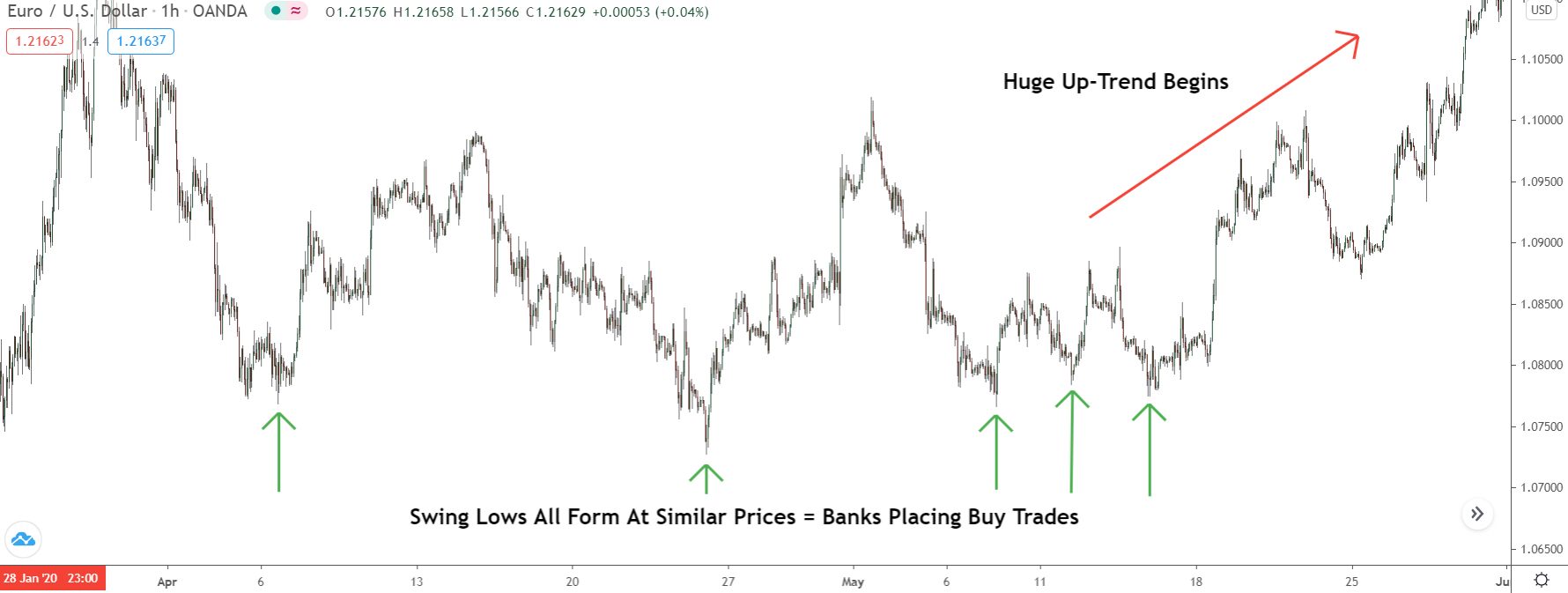
Every high is a sliver of the bank’s comprehensive trade, broken down into digestible pieces to trim the volume of necessary orders. These bits take shape at nearly identical prices – a strategy by the banks to mimic the act of placing a single trade at a singular price. This is their dream scenario if they had orders to spare.
Sure, we’re in the dark about whether the banks will slap down sell trades, potentially reversing the price. However, here’s a piece of intel we are privy to – if they choose to sell, we’re in for a show of multiple highs forming at similar prices. This tactic is their golden ticket to get those hefty trades settled into the market.
Moving on to the third scenario – banks closing trades – it’s pretty much a mirror image of scenario one.
No discernible difference there.
The conclusion of trades by the banks would instigate a retracement or consolidation, much like a profit-taking situation. Truth be told, it’s a tall order to pinpoint exactly what’s happening behind the scenes, and regardless, the end result remains the same.
Hence, we lump them together.
Alright, let’s zip back to our example and see who got it right..
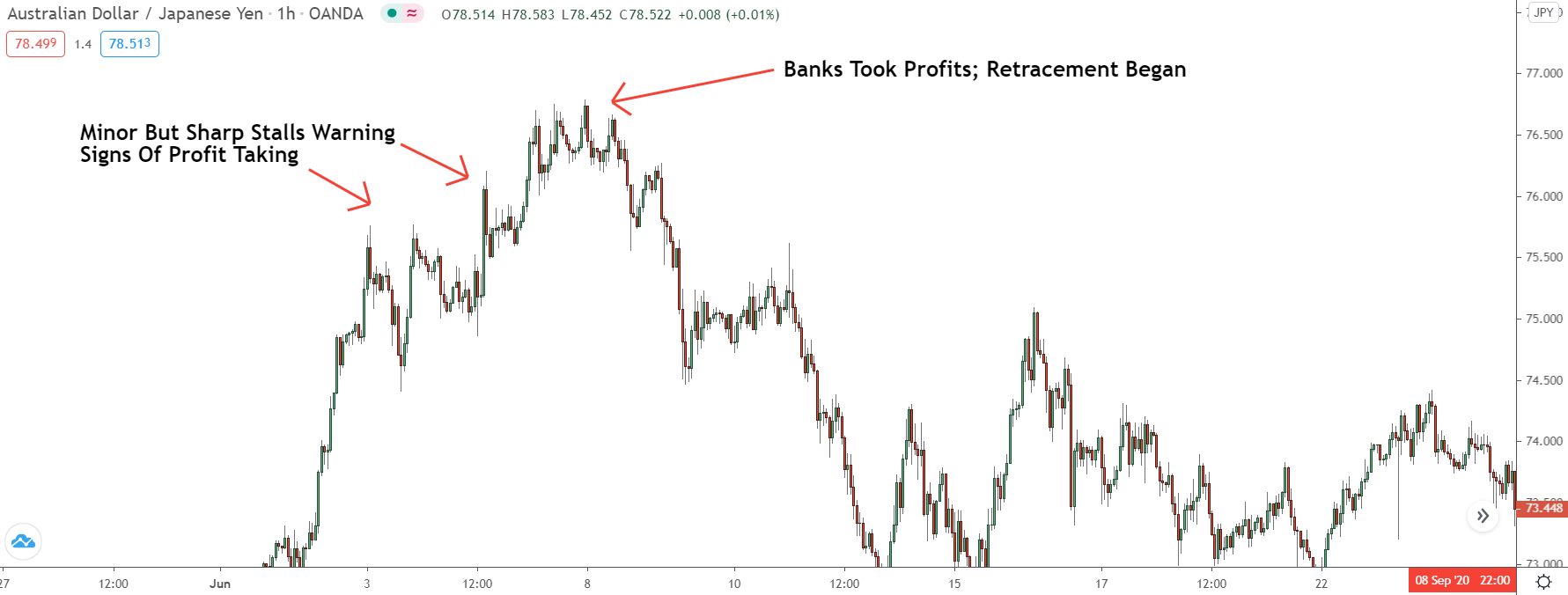
Did I hear someone say ‘profit-taking’?
In this scenario, the reversal was triggered by banks taking profits off buy trades. Now, you might be wondering, how do we know this?
Well, because price eventually flipped, paving the way for the uptrend to bounce back.
In the process of taking profits, not only did the banks manage to pocket their gains (obviously), but they also outmaneuvered the late entrants to the long positions. This maneuver prompted a substantial drop, which they deftly leveraged to place more buy trades at a sweeter price, thereby repositioning themselves for the continuation of the upward trend.

Sure, taking profits allowed the banks to fill their coffers (no brainer there!).
But the plot twist?
It also sent the late-coming longs from the sheep packing.
This strategic shakeout sparked a massive decline, which the banks cunningly exploited to place more buy trades – and at a sweet discount, might I add. In one stroke, they repositioned themselves to ride the wave of the continuing uptrend.
Talk about playing the market like a fiddle!
Why Stop Hunts Are So Important In Order Flow How To Predict Them In Advance
Earlier, I unpacked the concept of stop losses, illuminating their dual nature as both limit and market orders, depending on the stage – placement or execution.
In their role as limit orders, stop losses are liquidity enhancers, creating a safety net for transactions at a fixed price – the stop price.
The crux?
These orders get paired with a counter buy or sell, based on market direction, ensuring a trader’s order is locked in at that designated price.
Now, for us retail traders, having our orders filled is usually a breeze.
Our minuscule trades easily find matches whether we’re selling or buying.
But the story isn’t the same for the big fish – banks and large-cap traders. Their colossal orders call for a massive volume of counter-orders, transforming order placement, trade closure, and profit realization into significant asks.
The market often falls short of having enough free orders!
How do they sidestep this obstacle?
Simple, they stir the price towards significant clusters of orders, riding on them to secure their orders at competitive prices. These clusters are typically found at prominent round numbers, but they also lurk in massive stacks of stop orders.
Acting as limit orders, these stops serve as counterparties, facilitating the execution of the bank’s orders at the stop price.
Ever spotted your stop below a swing low, only to witness a price spike before a reversal?
I bet your gut screams, “That wasn’t random!”
And it wasn’t – it’s the banks at work.
They know traders habitually nestle their stops below swing lows and highs – a nugget of wisdom that every trading book boasts! So, they flex their muscles to steer the price towards these points, intentionally spiking the stops to lodge their own orders.
This tactic is infamously known as “stop hunting”.
You likely don’t need a lecture on the exasperation caused by stop hunting. I’ll wager you’ve been on the receiving end more times than you can count! But here’s the twist: with a sound understanding of order flow, you can actually anticipate stop hunts and ride the wave they create.
Sounds wild, doesn’t it?
So, the question of the hour – how do we track down these stop orders?
What’s our game plan?
Time to channel our inner ‘sheep’…
As a trading newbie, where were you taught to position your stop?
Let me guess… above a recent swing high or below a recent swing low, right? So, where do you suppose the ‘sheep’ drop their stops?
Bingo!
ABOVE pronounced swing highs and BELOW glaring swing lows.
But don’t take my word for it, see for yourself…
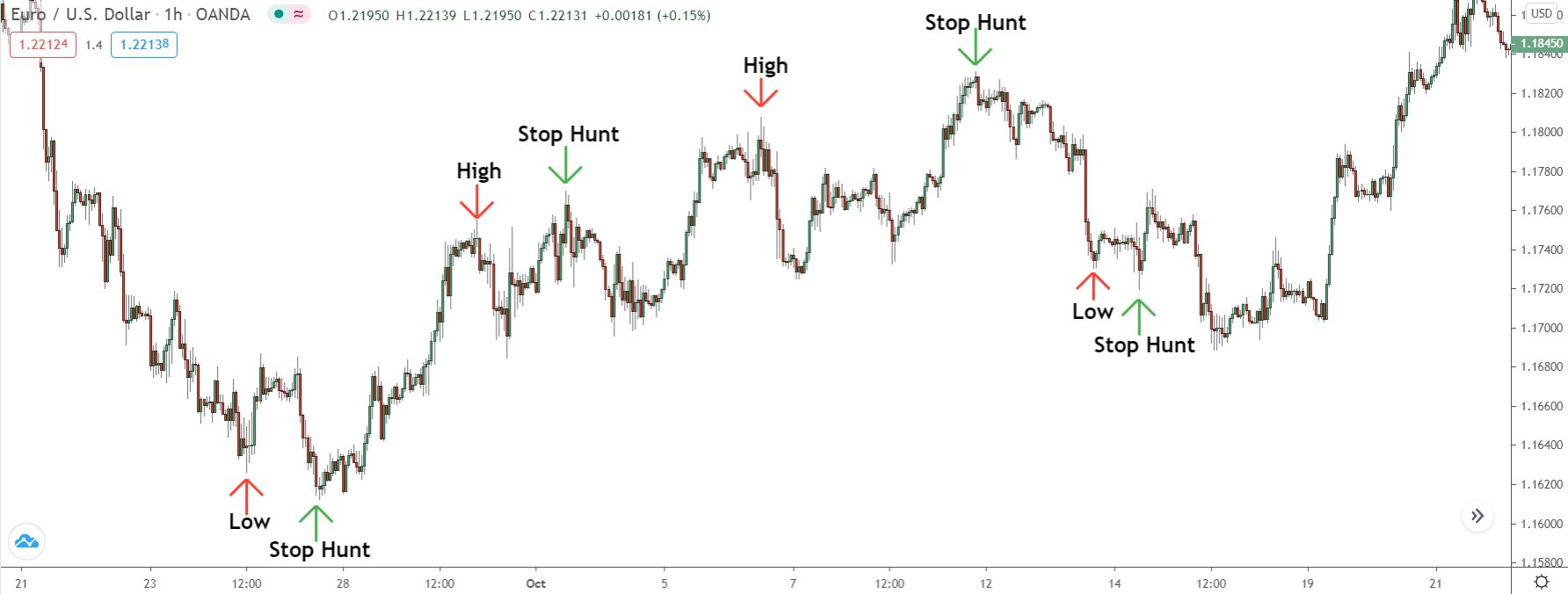
Five swing lows and highs shaped this section of price action, with three of them getting spiked before a price shift.
Accidental?
Absolutely not!
Banks are the culprits—they spiked the stops, throwing off retail traders (myself included on the third occasion), to plant their own orders and prompt each reversal.
So, what’s the next big question?
How can we predict this beforehand?
Firstly, keep an eye on the most recent swing lows or highs, brushing aside antiquated ones—they’re irrelevant. Stops primarily accumulate at these recent peaks and troughs. As price drifts, traders either take a hit or shift their stops to the latest swing lows or highs, safeguarding their profits.
Secondly, train your focus on striking highs and lows AFTER price hits rock bottom or skyrockets. This is crucial.
Banks will only instigate a stop run when a colossal number of stops amass beneath a swing low or above a swing high.
Two conditions are prerequisite:
- The low/high should be conspicuous—it should pop out amidst the prevailing price action (PA).
- The price must hit the floor or the ceiling—resting near the low/high for some time.
This reiterates the essence of order flow trading: grasping how other traders process and make decisions.
When the price plummets after a substantial downward trajectory, forming a visible swing low, a deluge of stops will accrue from reversal traders.
Anticipating a price flip, they dive in long.
Where will they plant their stops?
Exactly, at the most prominent swing low—the go-to spot every book and guru vouches as safe.
At this stage, banks swoop in, perform their orders, and yep— price reveses.
Keep an eye on the PA emerging during the stop run to position your trade—using the new low crafted by the stop run as the reference for placing your own stop loss.
The reverse holds true too:
If the low or high isn’t conspicuous—say, it’s a puny wick surrounded by similar ones—don’t expect a stop run. Banks won’t find it worthwhile. Only a handful of traders will station their stops below the low amidst confusing PA and multiple lows (or highs) creation—resulting in a meager pile-up of orders, inadequate for the banks’ objectives.
So, to pinpoint when and where a stop run could occur:
- Keep tabs on the recent swing lows and highs—stops don’t crowd at dated peaks or troughs.
- Identify standout lows or highs—those that scream for attention.
- Look out for a spike once the price has bottomed out or reached its zenith—specifically, after it has rested near the low/high for some time.
When the price breaches the swing and triggers the stops, be on high alert for price action signals—engulfing patterns, large pin bars, sudden moves—to dive into the reversal. Although this setup isn’t a piece of cake to trade, nailing it can offer entry into some grand reversals, boasting impressive risk/reward ratios.
Summary
Whoa, that was a hefty dose of knowledge, wasn’t it? You might need to kick back with a beverage or two after digesting all that. No wonder institutional traders steer clear of trading post-lunch!
Hopefully, this deep dive has shed some light on the mystique of Order Flow trading and how it ticks.
At its heart, Order Flow forms a fundamental pillar of my trading strategy and market perspective.
Sure, it’s no walk in the park to grasp, with its spotlight on orders, liquidity, and the thought process of traders.
But stick with it and prod at the mystery.
Wondering where traders have set their stops?
Curious about what the losing traders are up to?
Pondering when they’ll liquidate?
Speculating how banks might act in light of the current orders or situation?
Keep on digging, and before you know it, you’ll have a firm grip on Order Flow and how to wield it in a practical setting.
The Next Step? Learn The 5 Rules For Trading Supply Demand Like A PRO Trader...
Take your trading to the next level. Sign up today to download my FREE E-Book and learn how the pro's trade supply and demand - Includes Order Block PDF and S & D Guide PDF

Excellent Liam
Thank you for understanding how the big banks operate.Pure information. Good bless you our Mr Wall street
Good one ..I wish I could get it in pdf form
Under your section about ‘The Role of Liquidity. . .’ did you really mean to say that the ‘minors are highly illiquid’ or did you mean to say that the ‘exotics are highly illiquid’?
Haha, no I meant the exotics, Vernon. My mistake! All changed now… thanks for the heads up!
I’ve enjoyed your explanations until I reached your section about Liquidity. You said:
‘When buy-side liquidity falls, price rises. The buy orders are too small to match sell orders.’
Then later you say,
When the price falls, the sellers are selling too much for the buyers to handle.
So price falls….’
It would seems like you’ve said that too many sell orders cause price to rise and fall, which can’t be what you meant. I believe your second explanation seems more accurate based on your subsequent examples, but I’m afraid word problems make my head want to break, so I’m asking to understand if I’m getting something wrong.
Followup: After further reading, it appears that two of your sentences may have been swapped out or order. Does this seem correct?:
‘When buy-side liquidity falls, price rises. The sell orders are too small to match buy orders.’
‘When sell-side liquidity falls, price falls. The buy orders are too small to match sell orders.’ Also
A lack of liquidity means price MUST move in the opposite direction (of the order shortfall.)
This seems correct, but I will need your help to be sure. Thanks for helping.
Yes, Vernon, you’re right! I’ve got the sentences the wrong way around. I must’ve forgotten to change them during the editing process – it’s easy to miss these things, especially with a concept like liquidity. I’ve changed it now, so should make sense. I’ll go over the right of the post later to see if I missed anything else. Thanks again for the heads up, appreciate it, bud!
Very compresensive one bro, Kudos.
excellent one Liam!
I really need to be in touch with you but the link provided for the form is inactive.